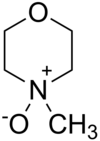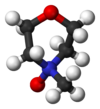N-Methylmorpholine N-oxide
|
|
|||
| Identifiers | |||
|---|---|---|---|
|
7529-22-8 |
|||
| 3D model (Jmol) | Interactive image | ||
| ChEBI |
CHEBI:52093 |
||
| ChemSpider |
74032 |
||
| ECHA InfoCard | 100.028.538 | ||
| PubChem | 82029 | ||
|
|||
|
|||
| Properties | |||
| C5H11NO2 | |||
| Molar mass | 117.15 g/mol | ||
| Melting point | 180 to 184 °C (356 to 363 °F; 453 to 457 K) | ||
|
Except where otherwise noted, data are given for materials in their standard state (at 25 °C [77 °F], 100 kPa).
|
|||
|
|
|||
| Infobox references | |||
N-Methylmorpholine N-oxide (more correctly 4-methylmorpholine 4-oxide), NMO or NMMO is an organic compound. This heterocyclic amine oxide and morpholine derivative is used in organic chemistry as a co-oxidant and sacrificial catalyst in oxidation reactions for instance in osmium tetroxide oxidations and the Sharpless asymmetric dihydroxylation or oxidations with TPAP. NMO is commercially supplied both as a monohydrate C5H11NO2·H2O and as the anhydrous compound. The monohydrate is used as a solvent for cellulose in the Lyocell process to produce cellulose fibers.
NMMO monohydrate is used as a solvent in the Lyocell process to produce Tencel fiber. It dissolves cellulose to form a solution called dope, and the cellulose is reprecipitated in a water bath to produce a fiber. The process is similar but not analogous to the viscose process. In the viscose process, cellulose is made soluble by conversion to its xanthate derivatives. With NMMO, cellulose is not derivatized but dissolves to give a homogeneous polymer solution. The resulting fiber is similar to viscose; this was observed, for example, for Valonia cellulose microfibrils. Dilution with water causes the cellulose to reprecipitate, i.e. the solvation of cellulose with NMMO is a water sensitive process.
...
Wikipedia


